1994 CADILLAC FLEETWOOD tires
[x] Cancel search: tiresPage 308 of 398
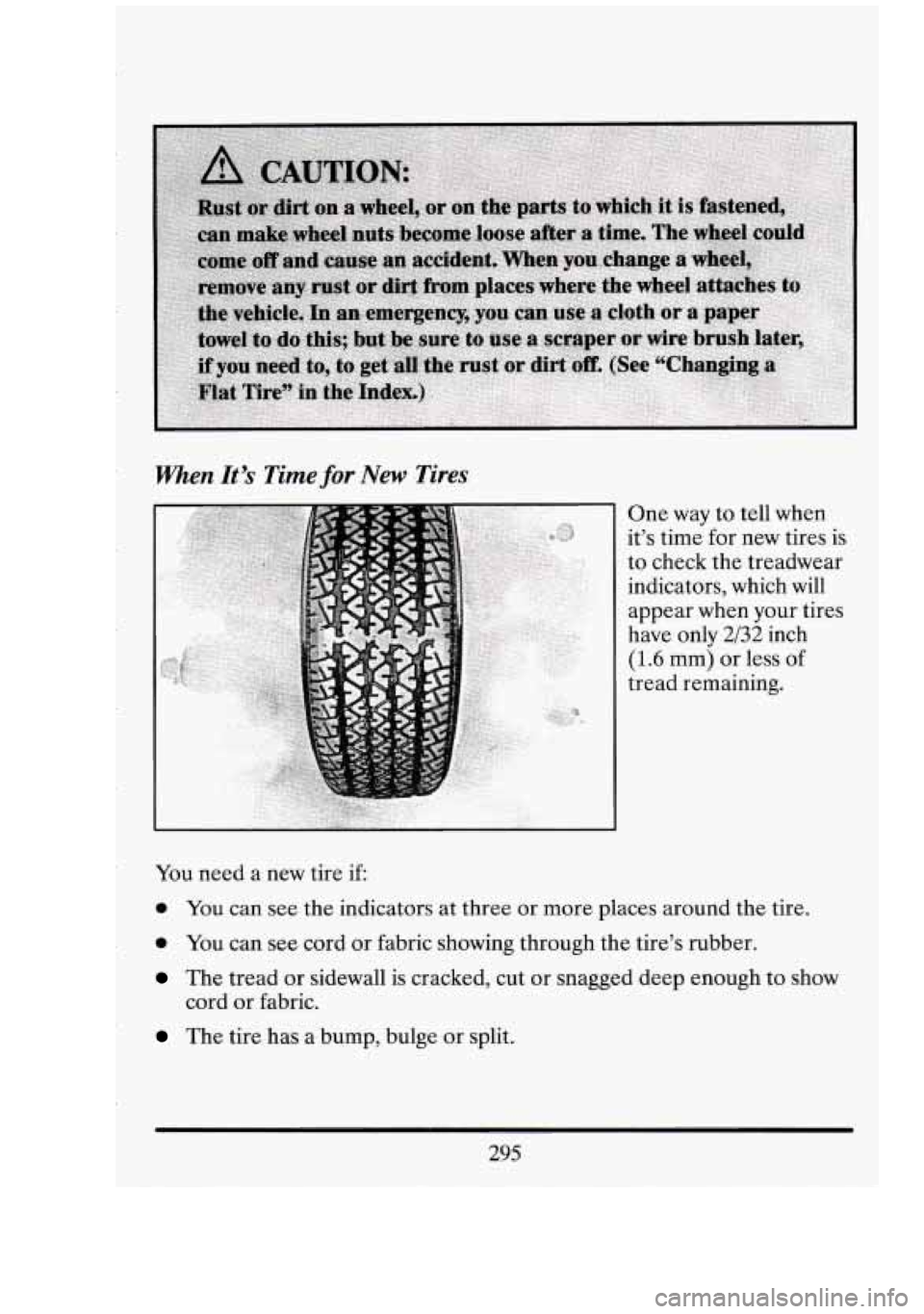
When It’s Time for New .Tires
You need a new tire if
One way to tell when
it’s time for new tires is
to check the treadwear
indicators, which
will
appear when your tires
have only
2/32 inch
(1.6 mm) or less of
tread remaining.
0 You can see the indicators at three or more places around the tire.
0 You can see cord or fabric showing through the tire’s rubber.
The tread or sidewall is cracked, cut or snagged deep enough to show
cord or fabric.
The tire has a bump,. bulge or split.
295
Page 309 of 398
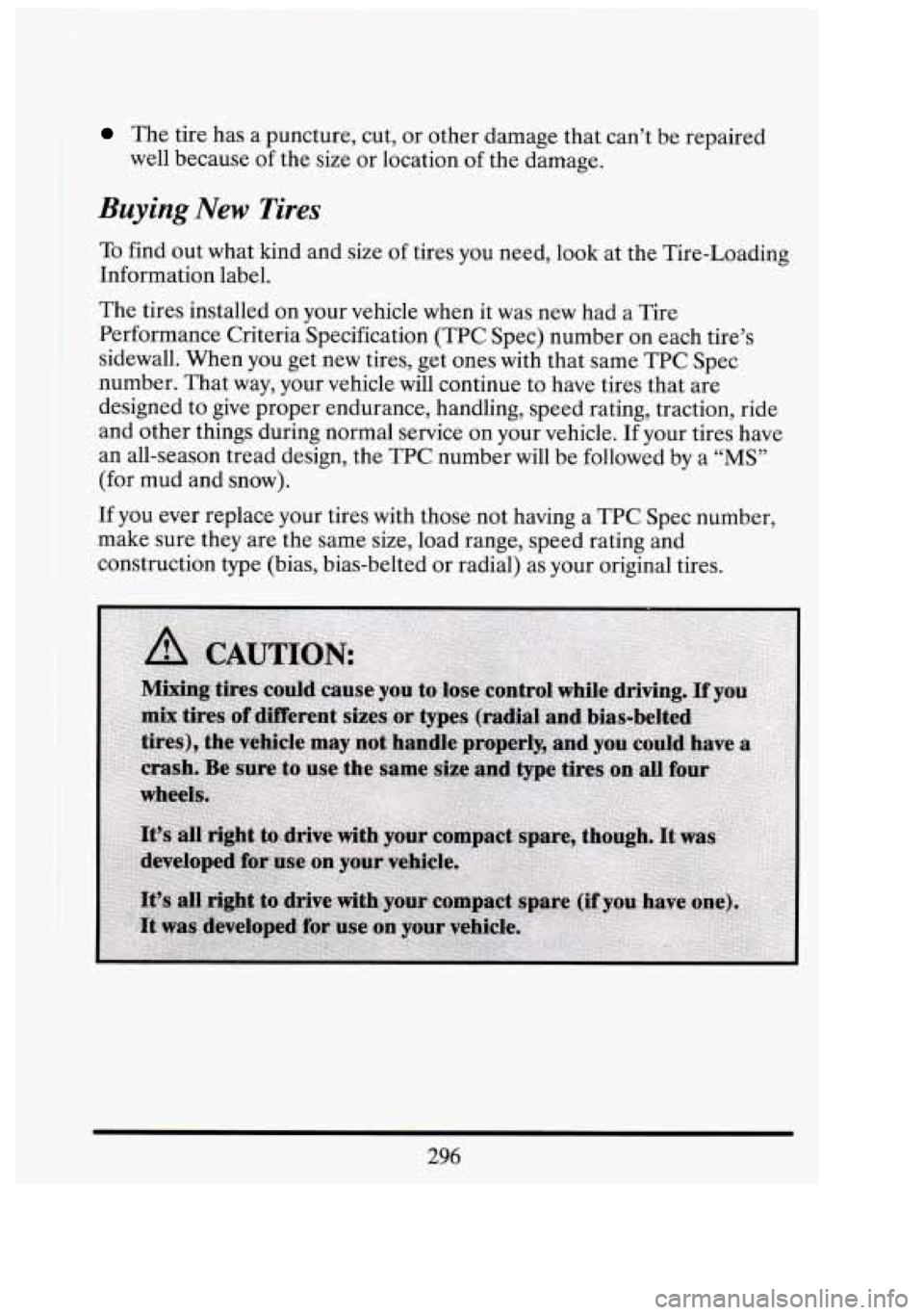
The tire has a puncture, cut, or other damage that can’t be repaired
well because of the size or location of the damage.
Buying New Tires
To find out what kind and size of tires you need, look at the Tire-Loading
Information label.
The tires installed on your vehicle
when it was new had a Tire
Performance Criteria Specification (TPC Spec) number on each tire’s
sidewall. When you get new tires, get ones with that same TPC Spec
number. That way, your vehicle will continue to have tires that are
designed to give proper endurance, handling, speed rating, traction, ride
and other things during normal service on your vehicle. If your tires have
an all-season tread design, the TPC number
will be followed by a “MS”
(for mud and snow).
If you ever replace your tires with those not having a TPC Spec number,
make sure they are the same size, load range, speed rating and
construction type (bias, bias-belted or radial) as your original tires.
ni
-1
Page 310 of 398
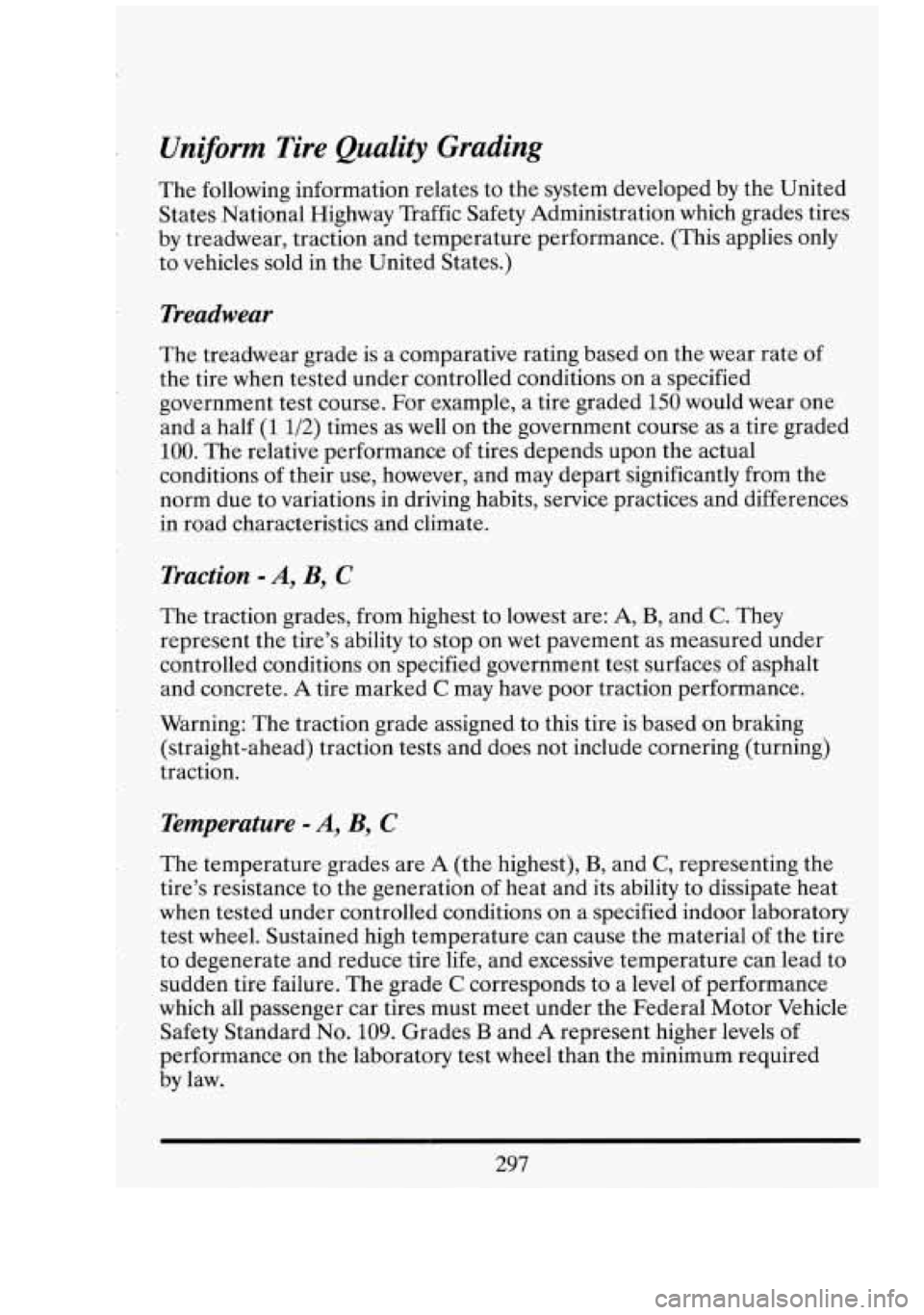
Uniform Tire Quality Grading
The following information relates to the system developed by the United
States National Highway Traffic Safety Administration which grades tires
by treadwear, traction and temperature performance. (This applies only
to vehicles sold
in the United States.)
Treadwear
The treadwear grade is a comparative rating based on the wear rate of
the tire when tested under controlled conditions on a specified
government test course. For example, a tire graded 150 would wear one
and
a half (1 1/2) times as well on the government course as a tire graded
100. The relative performance of tires depends upon the actual
conditions of their use, however, and may depart significantly from the
norm due to variations in driving habits, service practices and differences
in road characteristics and climate.
Traction - A, B, C
The traction grades, from highest to lowest are: A, B, and C. They
represent the tire’s ability to stop on wet pavement as measured under
controlled conditions on specified government test surfaces
of asphalt
and concrete. A tire marked
C may have poor traction performance.
Warning: The traction grade assigned to this tire is based
on braking
(straight-ahead) traction tests and does not include cornering (turning)
traction.
Temperature - A, B, C
The temperature grades are A (the highest), B, and C, representing the
tire’s resistance to the generation of heat and its ability to dissipate heat
when tested under controlled conditions on a specified indoor laboratory
test wheel. Sustained high temperature can cause the material of the tire
to degenerate and reduce tire
life, and excessive temperature can lead to
sudden tire failure. The grade
C corresponds to a level of performance
which all passenger car tires must meet under the Federal Motor Vehicle
Safety Standard No. 109. Grades
B and A represent higher levels of
performance on
the laboratory test wheel than the minimum required
by law.
297
Page 311 of 398

Warning: The temperature grade for this tire is established for a tire that
is properly inflated and not overloaded. Excessive speed, underinflation,
or excessive loading, either separately or in combination, can cause heat
These grades are molded on the sidewalls of passenger car tires.
I buildup and possible tire failure.
While the tires available as standard or optional equipment on General
Motors vehicles may vary with respect to these grades, all such tires meet
General Motors performance standards and have been approved for use
on General Motors vehicles.
All passenger type (P Metric) tires must
conform to Federal safety requirements in addition to these grades.
Wheel Alignment and Tire Balance
I
The wheels on your vehicle were aligned and balanced carefully at the
factory to give you the longest tire life and best overall performance.
In most cases, you will not need to have your wheels aligned again.
However, if you notice unusual tire wear or your vehicle pulling one way
or the other, the alignment may need to be reset. If
you notice your
vehicle vibrating when driving on a smooth road, your wheels may need
to be rebalanced.
Wheel Rephcement
Replace any wheel that is bent, cracked or badly corroded. If wheel nuts
keep coming loose, the wheel, wheel bolts, and wheel nuts should be
replaced.
If the wheel leaks air, replace it (except some aluminum wheels,
I which can sometimes be repaired). See your Cadillac dealer if any of
these conditions exist.
Your dealer will know the kind
of wheel you need.
Each new wheel should have the same load carrying capacity, diameter,
width, offset, and be mounted the same way as the one it replaces.
If you need to replace any of your wheels, wheel bolts, or wheel nuts,
replace them only with new GM original equipment parts. This way, you
will be sure to have the right wheel, wheel bolts, and wheel
nuts for your
Cadillac model.
I
ni
298
-
Page 313 of 398
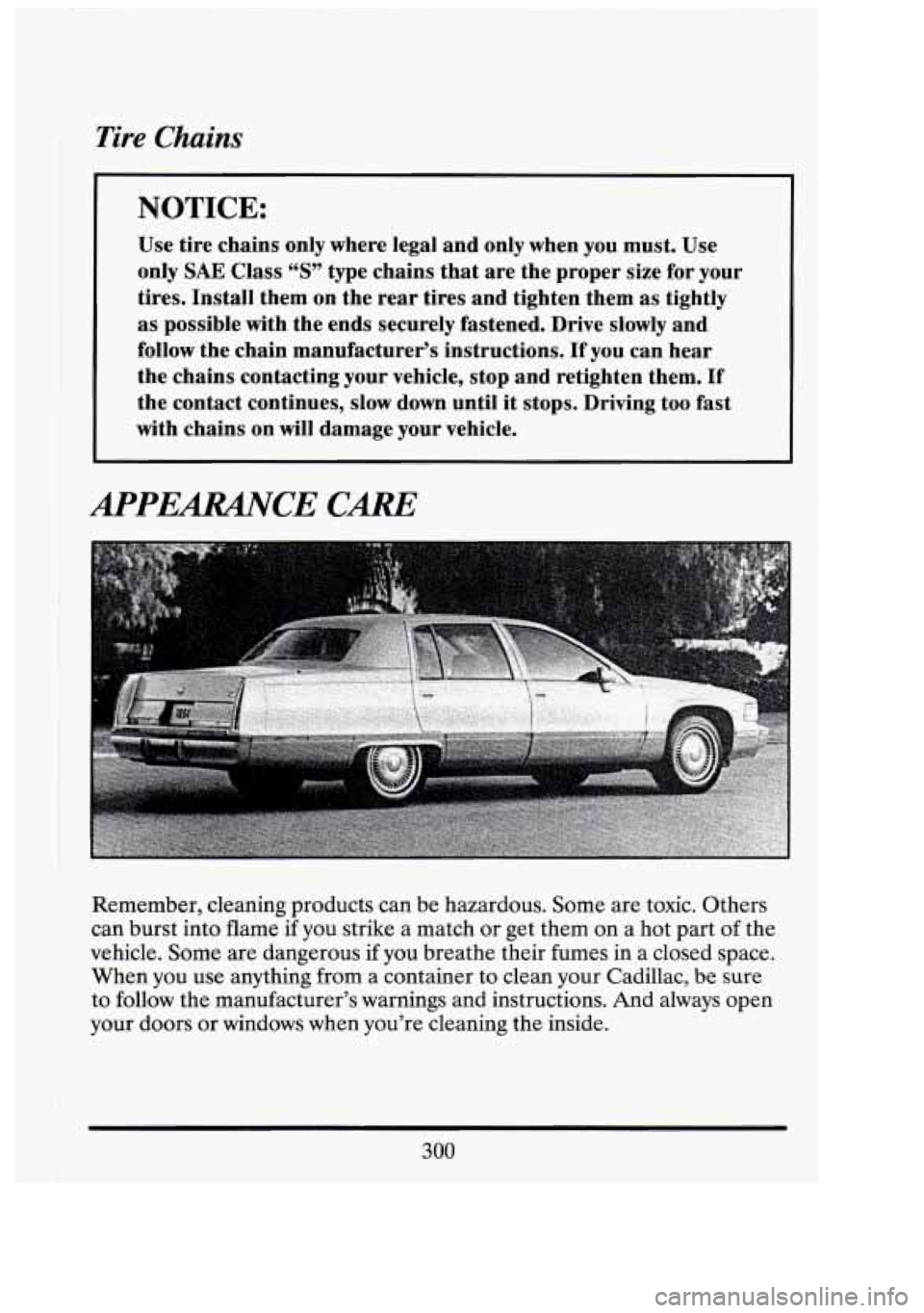
Tire Chains
NOTICE:
Use tire chains only where legal and only when you must. Use
only
SAE Class “S” type chains that are the proper size for your
tires. Install them
on the rear tires and tighten them as tightly
as possible with the ends securely fastened. Drive slowly and
follow the chain manufacturer‘s instructions.
If you can hear
the chains contacting your vehicle, stop and retighten them. If
the contact continues, slow down until it stops. Driving too fast
with chains on
will damage your vehicle.
APPEARANCE CARE
Remember, cleaning products can be hazardous. Some are toxic. Others
can burst into flame if
you strike a match or get them on a hot part of the
vehicle. Some are dangerous
if you breathe their fumes in a closed space.
When you use anything from a container
to clean your Cadillac, be sure
to follow the manufacturer’s warnings and instructions. And always open
your doors or windows when you’re cleaning the inside.
300
-1
n
1
”I
li 11.11
3
Page 320 of 398
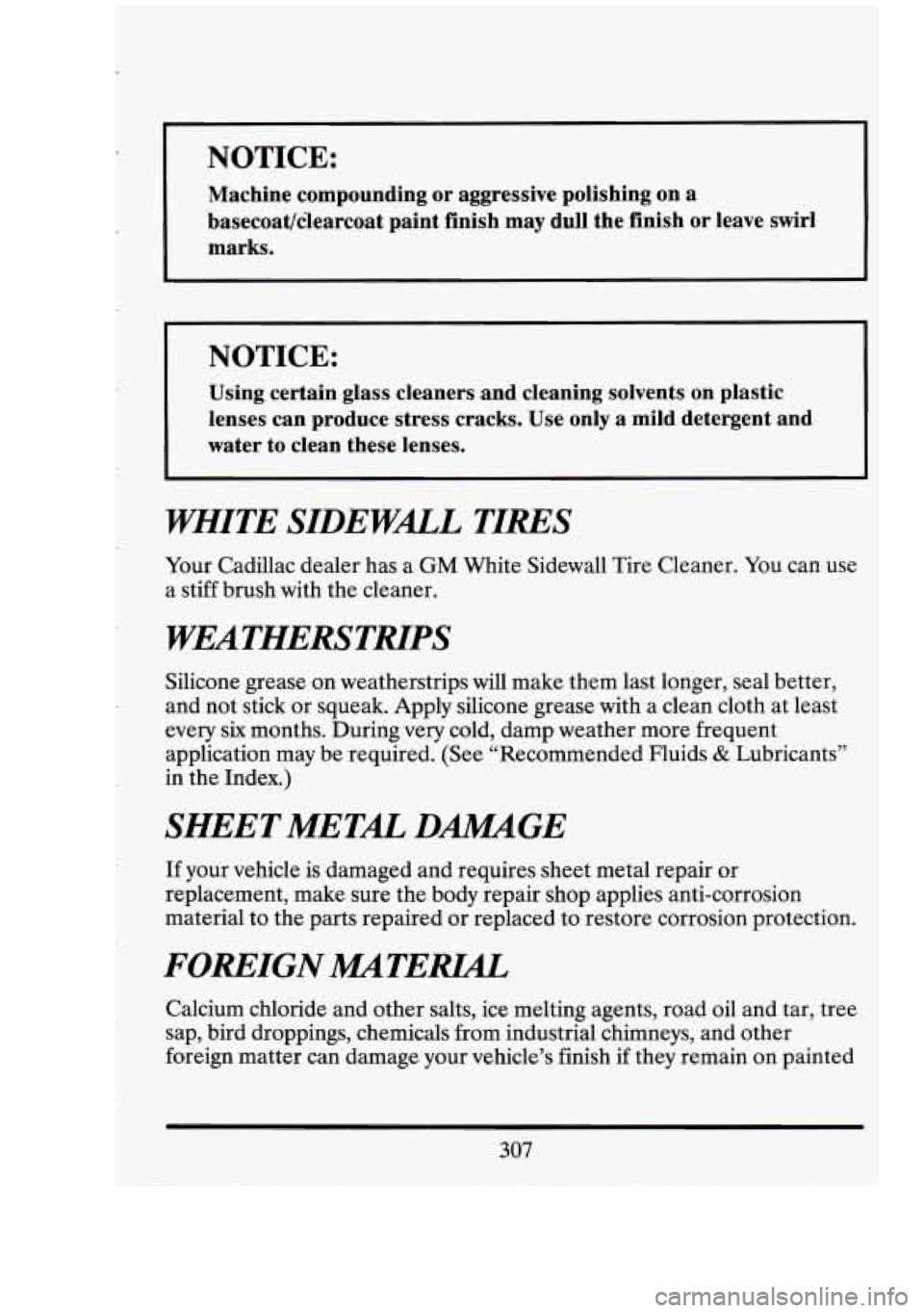
I NOTICE: I
Machine compounding or aggressive polishing on a
basecoat/clearcoat paint finish may dull the finish or leave swirl
marks.
NOTICE:
Using certain glass cleaners ,and cleaning solvents on plastic
lenses can produce stress cracks. Use only a mild detergent and
water to clean these lenses.
WHITE SIDEWALL TIRES
Your Cadillac dealer has a GM White Sidewall Tire Cleaner. You can use
a stiff brush with the cleaner.
WEATHERSTRIPS
Silicone grease on weatherstrips will make them last longer, seal better,
and not stick or squeak. Apply silicone grease with a clean cloth at least
every six months. During very cold, damp weather more frequent
application may be required. (See “Recommended Fluids
& Lubricants”
in the Index.)
SHEETMETAL DMGE
If your vehicle is damaged and requires sheet metal repair or
replacement, make sure the body repair shop applies anti-corrosion
material to the parts repaired or replaced to restore corrosion protection.
FOREIGN MATERLAL,
Calcium chloride and other salts, ice melting agents, road oil and tar, tree
sap, bird droppings, chemicals from industrial chimneys, and other
foreign matter can damage your vehicle’s finish if they remain on painted
307
Page 322 of 398

APPEGACE CAREMATERLZS CIiART
w NUMBER
I
1052277 12 OZ. (0.354 L)
1050172 .16 OZ. (0.473 L)
1050173 16 OZ. (0.473 L)
10501 74 16 OZ. (0.473 L)
105021 4 32 02. (0.946 L)
1050244 16 OZ. (0.473 L)
1050427 23 OZ. (0.680 L)
I
1050429 6 LB. (2.72 KG)
1052349 12 OZ. (0.354 L)
1050.729 8 OZ. (0.237 L)
1052870 16 OZ. (0.473 L)
1051 398
8'02. (Oi237 L)
DESCRIPTION,
SPRAY-A-SQUEAK
TAR AND ROAD OIL
REMOVER'
C.HROME CLEANER
AND POLISH
WHITE SIDEWALL
TIRE CLEANER
VINYL/LEATHER CLEANER
FABRIC CLEANER
GLASS CLEANER MULTI-PURPOSE
POWDERED
CLEANER
~~
LUBRIPLATE (WHITE GREASE)
VINYL TOP CLEANER
WASH-WAX (CONC.) SPOT LIFTER
GM OPTIKLEEN
MAGIC MIRROR
CLEANER POLISH
USAGE
WEATHER STRIPS-STOPS
SQUEAKS
ON,
METAL-TO-METAL AND
METAL-TO-RUBBER
CO.NTACT
REMOVES OLD WAXES,
POLISHES, TAR AND ROAD
01 L
REMOVES RUST AND
CORROSION ON CHROME
AND STAINLESS' STEEL
CLEANS WHITE AND BLACK TIRES
SPOT AND STAIN REMOVAL
ON LEATHER
OR VINYL
SPOT AND STAIN REMOVAL
ON CLOTH AND FABRIC
GLASS CLEANING AND
SPOT CLEANING ON VINYLS
CLEANS VINYL AND CLOTH
ON DOOR TRIM, SEATS,
AND MATS AND CARPET-ALSO, TIRES
GREASE FOR HOOD,
TRUNK AND DOOR HINGES
AND LATCHES
CLEANING OF VINYL TOPS
EXTERIOR WASH
SPOT AND STAIN REMOVAL
ON CLOTH A,ND FABRIC
WINDSHIELD WASHER SOLVENT AND
ANTI-FREEZE
EXTERIOR CLEANER AND
POLISH,
309
Page 391 of 398
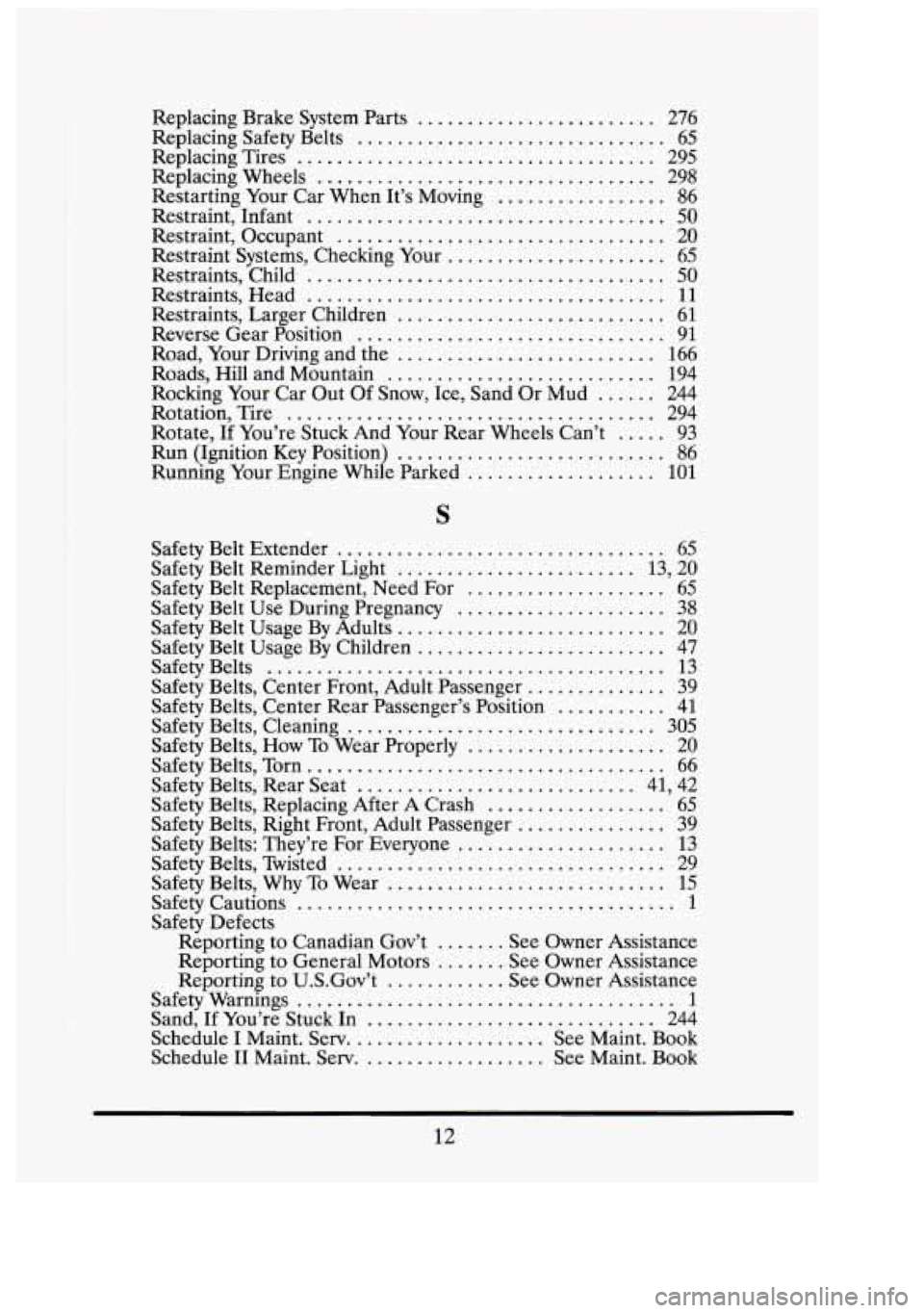
Replacing Brake System Parts ........................ 276
Replacing Safety Belts
............................... 65
Replacing Tires
.................................... 295
Replacing Wheels
.................................. 298
Restarting Your Car When It’s Moving
................. 86
Restraint. Infant
.................................... 50
Restraint. Occupant ................................. 20
Restraint Systems. Checking Your ...................... 65
Restraints. Child
.................................... 50
Restraints. Head .................................... 11
Restraints. Larger Children ........................... 61
Reverse Gear Position
............................... 91
Road. Your Driving and the
.......................... 166
Roads. Hill and Mountain
........................... 194
Rocking Your Car Out Of Snow. Ice. Sand Or Mud
...... 244
Rotation. Tire
..................................... 294
Rotate. If You’re Stuck And Your Rear Wheels Can’t
..... 93
Run (Ignition Key Position)
........................... 86
Running Your Engine While Parked
................... 101
S
Safety Belt Extender ................................. 65
Safety Belt Reminder Light ........................ 13’20
Safety Belt Replacement. Need For
.................... 65
Safety Belt Use During Pregnancy
..................... 38
Safety Belt Usage By Adults
........................... 20
Safety Belt Usage By Children
......................... 47
SafetyBelts
........................................ 13
Safety Belts. Center Front. Adult Passenger
.............. 39
Safety Belts. Center Rear Passenger’s Position
........... 41
Safety Belts. How To Wear Properly
.................... 20
Safety Belts. Cleaning
............................... 305
Safety Belts. Torn
.................................... 66
Safety Belts. Rear Seat
............................ 41. 42
Safety Belts. Replacing After A Crash
.................. 65
Safety Belts. Right Front. Adult Passenger
............... 39
Safety Belts: They’re For Everyone
..................... 13
Safety Belts. Why
To Wear ............................ 15
Safety Defects Safety Belts. Twisted
................................. 29
Safety Cautions
...................................... 1
Reporting to Canadian Gov’t ....... See Owner Assistance
Reporting to General Motors
....... See Owner Assistance
Reporting to U.S.Gov’t
............ See Owner Assistance
Safety Warnings
...................................... 1
Sand. If You’re Stuck In ............................. 244
Schedule I Maint
. Serv .................... See Maint . Book
Schedule I1 Maint
. Serv ................... See Maint . Book
II
Lj.
-1
P
E’ 1